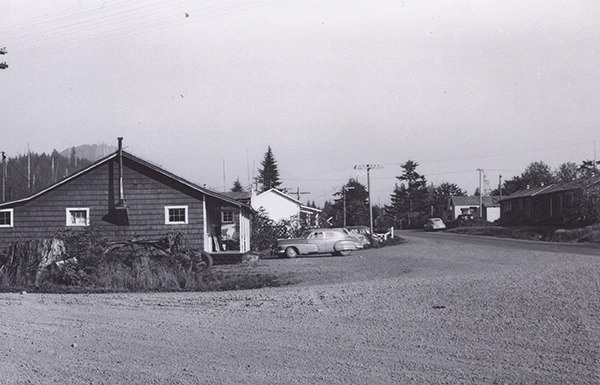In February 2009, the roof of the old building that stood at the Sappho junction finally gave out under the weight of snow.
In 1929, J.M. “Pop Goody” Goodwin constructed a building to serve as a tavern he called Goody’s. Bloedel Donovan had moved a logging camp to the town of Sappho. The town is believed to be named after a Greek poet, by an earlier resident, and the camp consisted of railroad facilities, bunkhouses, a store, post office and company houses.
Goodwin’s daughter Joline Wittenborn remembered the tavern being a very busy place. During World War II, Wittenborn recalls “Pop” enlisting the help of local women to bake bread and cookies and then inviting the soldiers from the Quillayute Air Base to come enjoy some home cooking. Many of those men and their families wrote letters and stayed in contact with “Pop” long after the war was over.
Lucille Duncan’s father Victor Udd was a mechanic or donkey doctor for Bloedel in the 1930s. They lived in one of the company houses. When asked what she remembered about the house she said, “We had an indoor bathroom!” She recalls her and her sister Eleanor roller skating on Highway 101.
In 1945, Bloedel sold to Rayonier and in 1948 the late Phyllis Munro was living in Vancouver, B.C. Her husband, George “Mac” Munro, had served in World War II and had family in Port Angeles. He had found a job at the Sappho Camp office and it came with a house.
With little construction during the war, houses were hard to come by, so this was a bonus. Having been accustomed to city life, Mrs. Munro’s arrival at her new “home” in a logging camp was a bit of a shock.
Peeling wallpaper, a toilet on the back porch and a rusty pipe with no shower head for bathing was what awaited her.
And when after a few years she got a real bathroom she found out they were moving to the Hoko.
They later returned to Sappho and also lived in Sekiu for many years. Munro said she would do it all over again, when talking about her logging camp days.
In 1949, Jack Olson, my father, went to work at Sappho Camp. He lived in one of the bunkhouses. There were eight bunks to each house and a stove in the middle.
The food was good and there was lots of it but he does remember one morning when ants invaded the syrup pitchers at the cookhouse.
An old busheler sitting next to him killed the ants and ate the syrup on his pancakes anyway. Lunches were packed for the workers and then extra items like cakes and pie could be added from the “spike” table.
When it came time to do laundry the camp had steam washing machines. Olson said, “You would take your pants and put them in the steel box. Turn the steam on and it would start to rumble. If you turned the steam up too much, it would blow your pants to pieces.” And he remembers Goodies tavern right across the street from the bunkhouses.
In 1974, Goody’s Tavern closed after Pop’s son Robert was found deceased there, the victim of a homicide, which remains unsolved. In a poem written by the Greek poet Sappho, she says, “Someone, I tell you, in another time, will remember us.” Maybe the same will hold true for Sappho, a place to be remembered.


